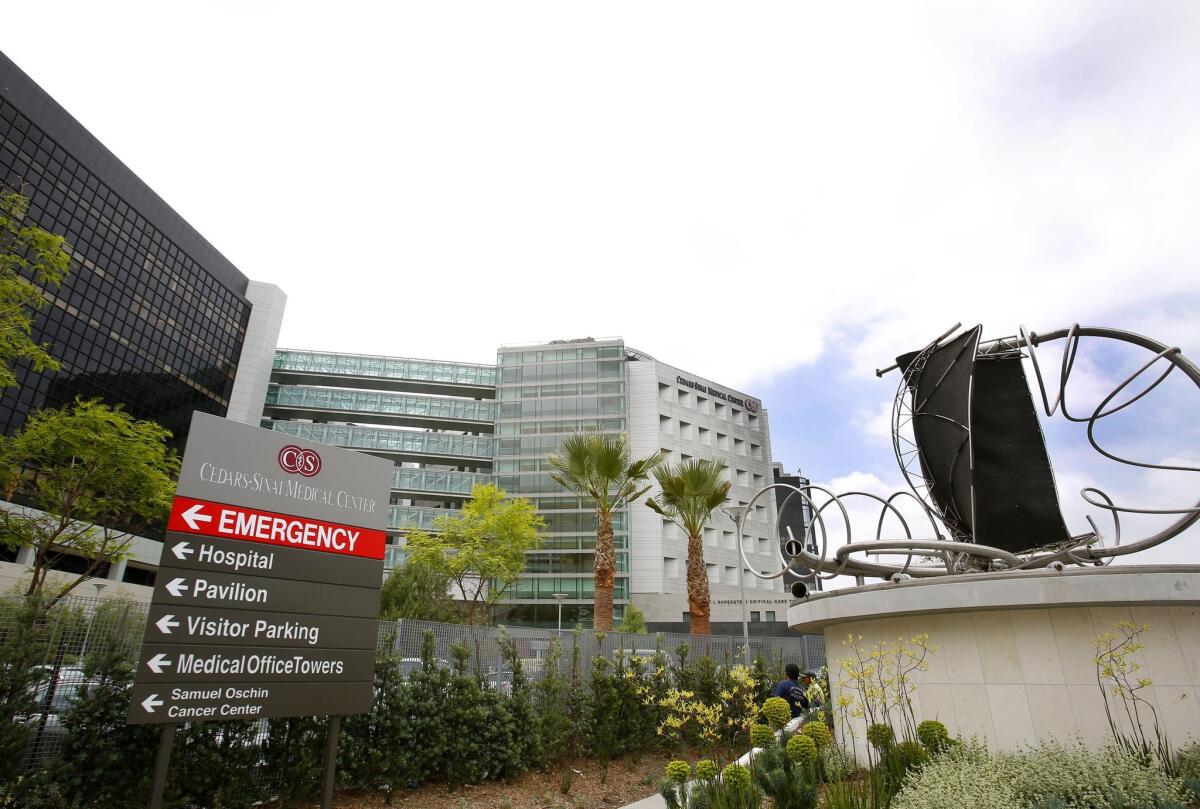Insurers limiting doctors, hospitals in health insurance market

The doctor can’t see you now.
Consumers may hear that a lot more often after getting health insurance under President Obama’s Affordable Care Act.
To hold down premiums, major insurers in California have sharply limited the number of doctors and hospitals available to patients in the state’s new health insurance market opening Oct. 1.
New data reveal the extent of those cuts in California, a crucial test bed for the federal healthcare law.
QUIZ: How much do you know about health care?
These diminished medical networks are fueling growing concerns that many patients will still struggle to get care despite the nation’s biggest healthcare expansion in half a century.
Consumers could see long wait times, a scarcity of specialists and loss of a longtime doctor.
“These narrow networks won’t work because they cut off access for patients,” said Dr. Richard Baker, executive director of the Urban Health Institute at Charles Drew University of Medicine and Science in Los Angeles. “We don’t want this to become a roadblock.”
To see the challenges awaiting some consumers, consider Woodland Hills-based insurer Health Net Inc.
Across Southern California the company has the lowest rates, with monthly premiums as much as $100 cheaper than the closest competitor in some cases. That will make it a popular choice among some of the 1.4 million Californians expected to purchase coverage in the state exchange next year.
But Health Net also has the fewest doctors, less than half what some other companies are offering in Southern California, according to a Times analysis of insurance data.
GRAPHIC: Prices in California’s health exchange
In Los Angeles County, for instance, Health Net customers in the state exchange would be limited to 2,316 primary-care doctors and specialists. That’s less than a third of the doctors Health Net offers to workers on employer plans. In San Diego, there are only 204 primary-care doctors to serve Health Net patients.
Other major insurers have pared their list of medical providers too, but not to Health Net’s degree. Statewide, Blue Shield of California says exchange customers will be restricted to about 50% of its regular physician network.
In response, California officials have been pressing Health Net and other insurers to add more doctors since companies filed their initial rosters in May. The state exchange, Covered California, says it will monitor enrollment closely once it begins next month and it’s prepared to step in if problems arise.
“Our interest is in assuring everyone enrolled in a plan has ready access to the clinicians they need,” said Peter Lee, executive director of Covered California. “That means if a plan can’t serve patients, we’ll close it down from taking new enrollment. That is in some ways the nuclear option.”
Rather than mere head count, officials say they are scrutinizing what capacity physicians have to accept new patients. And to assist consumers, California will enable people to search for specific doctors online during enrollment to determine what, if any, health plans they will be part of in Covered California.
“Does the doctor have room for one more patient or 40 patients? It’s about available seats,” Lee said. “We want to make sure every network has enough doctors.”
Health Net says price will probably matter most to the uninsured and people who buy their own health insurance now, so it built a narrow network to serve those “value seekers.”
“We have more than enough doctors for our projected enrollment through 2014, and we have time to adjust if it becomes necessary,” Health Net spokesman Brad Kieffer said. “We continue reaching out to providers, and we are bringing more on board.”
In recent months, the top priority for state officials and insurers has been affordable premiums. A smaller panel of doctors and hospitals generally yields lower rates because insurers can negotiate better discounts with providers who receive more patients.
Insurers and some consumer advocates think people are willing to trade some choice in order to pay less. More employers have been adopting these narrower networks in recent years to trim their own healthcare bills.
The California Medical Assn., which represents more than 37,000 doctors statewide, thinks the state is underestimating the difficulties ahead.
Based on its research, the organization is skeptical of the state’s claim that its health plans will cover about 80% of all California physicians. Other doctors worry about the effect on certain Latino and African American communities that have been historically underserved.
Covered California says it’s still compiling a list of all providers for the 12 health insurers in the exchange.
Supporters of the healthcare law say these types of problems are inevitable in rolling out such a massive program. Overall, they say, millions of consumers stand to benefit from guaranteed coverage regardless of preexisting medical conditions and the protection from financially crippling medical bills.
But some health policy experts say that medical costs will continue to escalate if patients can’t see their doctor regularly and get the follow-up care they need for chronic conditions such as diabetes. Similar concerns over patient access have surfaced in other states such as Maine and Wisconsin.
“We are nervous about these narrow networks,” said Donald Crane, chief executive of the California Assn. of Physician Groups. “It was all about price. But at what cost in terms of quality and access? Is this contrary to the purpose of the Affordable Care Act?”
The federal law requires exchange plans to include enough providers so that services are available “without unreasonable delay.” Likewise, state law sets various requirements for “network adequacy” so patients have enough doctors and hospitals nearby.
The differences in network size are noticeable across Southern California. Health Net has 920 physicians in Orange County, compared with more than 2,500 for Blue Shield, according to company data. Health Net has fewer than 800 doctors in San Diego County, while nearly 3,000 physicians are available in an Anthem Blue Cross plan.
In addition to doctors, some big-name hospitals may be left out. A spokesman for Cedars-Sinai Medical Center said the hospital has received many calls from patients who were worried about keeping their access to the hospital and its affiliated doctors in the new health plans next year.
Cedars-Sinai is available only on two lower-priced Health Net plans in the state-run market, according to the hospital and insurer. Anthem Blue Cross says that it’s the only insurer that includes UCLA Medical Center and other UC facilities statewide.
In some ways, insurers are mimicking HMO giant Kaiser Permanente, which has limited patients to its own hospitals and doctors for decades. Kaiser is offering its full slate of in-house providers in the exchange, totaling more than 5,700 doctors in the Los Angeles area.
Newly released data show the pricing power of these tighter networks. In Los Angeles County, Health Net is consistently the lowest-cost option for a mid-level Silver plan across various age groups.
A family of four in Norwalk earning $65,000 annually would pay $384 a month for a Health Net policy, after taking into account a federal subsidy based on their income. For a policy with identical benefits, Blue Shield was next at $477 a month and Kaiser was the most expensive at $602.
The cheapest Silver plan for a couple in their mid-50s earning nearly $100,000 a year was also Health Net at $781 a month. An Anthem policy costs $897. Consumers can check prices at https://www.coveredca.com.
“Health Net will get a lot of business with those rates,” said Glen Futterman, a health insurance broker in Woodland Hills. “But no one mentions you might not be able to see your doctor.”
Twitter: @chadterhune
Times researcher Sandra Poindexter contributed to this report.
More to Read
Inside the business of entertainment
The Wide Shot brings you news, analysis and insights on everything from streaming wars to production — and what it all means for the future.
You may occasionally receive promotional content from the Los Angeles Times.











